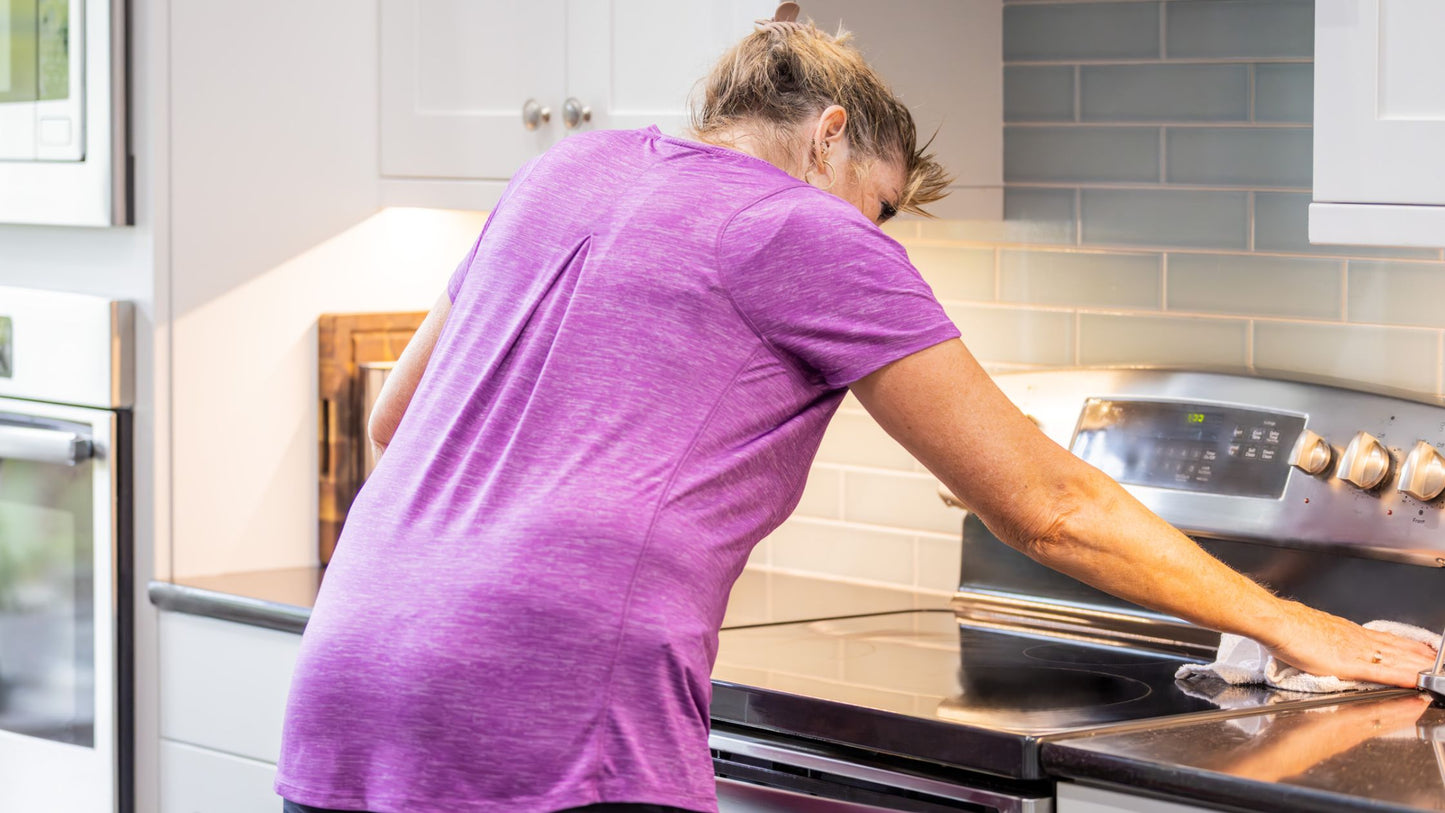
Over half of all US kitchens have electric or gas glass top stoves; these appliances are prone to spills, smudges, and smears. Routinely cleaning your glass cooktop will keep it looking new and functioning well. This post will share a step-by-step guide to deep cleaning your glass top stove.
To deep clean glass top stoves: Ensure the stovetop is cold to the touch before cleaning, spray a streak-free glass cleaner, wipe with a towel, reapply the cleaner and use a plastic razor blade to remove stubborn grime, then dry thoroughly. Wait at least half an hour before using the newly cleaned stovetop.
Product list
- A streak-free glass cleaner <LINK>
- Dry towels
- For stubborn grime – a plastic razor blade
Ensure the stove top is cold to the touch before cleaning
Before using any cleaner, check the temperature of the cooking surface. Applying cleaner to your stovetop before it’s cool will prematurely evaporate the solution. Also, you risk damaging your cooktop if you apply any unheated liquid to its hot surface. Only attempt to clean a stove that has been off for some time.
Spray a streak-free glass cleaner
Choose a streak-free glass cleaner with no added scents or dyes. Scented cleaners work by leaving behind a film that gives off a fragrance. While that might be something you would like for a bathroom counter or mirror, you will want to leave behind a spotless stovetop, as this surface must reach high temperatures.
Spray a small amount of streak-free glass cleaner onto the stove's surface. You want to apply a thin, even layer.
If you need a glass cleaner, try Invisible Glass <LINK>. It has no scents or dyes, and it’s a strong, effective option that’ll perform well for experienced weekend warriors or first-time scourers.
Wipe with a towel
Once you’ve applied a thin, even layer onto your cooktop, begin wiping down with a towel. Use long strokes, wiping either horizontally or vertically. For a spotless finish, avoid using circular motions that allow the cleaning solution to pool on the glass – leading to streaks or spots.
Food spatter combined with intense heat often creates stubborn grime, grease, or deposit buildups that a standard glass cleaner and towel might struggle to clean. You will need more friction than a towel can offer.
Reapply cleaner and use a plastic razor blade to remove stubborn grime
Important: Only use plastic razors on your cooktop. Metal razors will also work; however, metal may scratch delicate glass. Plastic razors are sharp enough to scrape off debris but won’t be hard enough to cause damage.
If you haven’t cleaned in a while, your stovetop will likely have baked-on grime that even a strong glass cleaner can’t effectively remove. For areas like this, we recommend following these steps:
- Spray the area with a glass cleaner.
- Let the solution sit for several minutes to help break down the grime.
- Using a plastic razor blade, carefully scrape away the debris.
- Reapply glass cleaner, repeating steps 1-3 as needed.
- Wipe up any remaining solution.
If you have any areas that remain dirty, you should address them using a product-specific cleaner. Purchase a ceramic and glass cooktop cleaner. These products contain mild abrasives that may remove stubborn stains.
Thoroughly dry your stovetop
Once your glass surface is clean, dry the stovetop to remove any lifted debris and remaining solution. Wait at least half an hour before using your newly cleaned stove top to allow any liquids or solution to evaporate.
Ways to Keep your Glass Top Stove Looking Spotless
We’re all strapped for time, but the great news is you can take several small steps daily to save on future cleaning time.
Everyday Wipe Down
The easiest way to clean your cooktop is to wipe it down after each use. After your cooking surface is cool, use a sponge or microfiber towel to wipe it down with plain or soapy water or, if you prefer, a solution of water and vinegar. This simple step will remove everyday smudges and smears.
Cook carefully and clean up spills!
Prevention is best. Watch your pots and pans as you cook to prevent splatters and overflow.
Despite your best efforts, spills will happen, but the sooner you address them, the less time they’ll burn onto your surface. Clean up spills and splatters promptly. A simple wipe takes seconds, faster than cleaning baked-on foods.
Weekly Washing
The more you clean, the less time you have to spend cleaning. Cleaning your glass top stove every week will prevent the build-up of grime. If you cook carefully and wipe up spills, you won’t need to chip away at baked-on debris. A straightforward wipedown with a scent- and dye-free glass cleaner should suffice.
Waxing your stove?
You’ve heard of car wax, but how about stovetop wax? Waxing a cooktop can drastically reduce future cleaning time.
You can apply car wax to your cooktop using the same methods you use on your vehicle. Just as car wax protects your car, it can provide a temporary barrier to protect your glass stove top. The wax layer makes your cooking surface smooth and slippery, making it harder for grime to stick to the glass.
Clean stress-free
Cleaning a glass stove top is a necessary evil. The longer you wait to clean, the more complicated and time-consuming it becomes.
Give your cooktop a thorough cleaning by following these steps: Ensure the stovetop is cold to the touch before cleaning, spray a streak-free glass cleaner, wipe with a towel, reapply the cleaner and use a plastic razor to remove stubborn grime, then dry thoroughly.
Once you have a spotless surface, maintain your glass stovetop with daily wipedowns and weekly once-overs. With these simple steps, you’ll feel like an executive chef at the helm of your squeaky-clean gourmet stove. Bon appétit!



